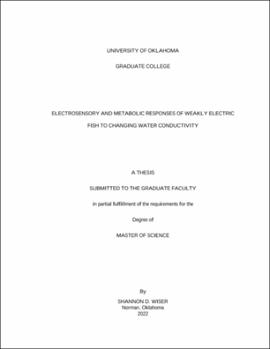| dc.description.abstract | South American weakly electric fishes (Gymnotiformes) use self-generated electric fields, known as electric organ discharges (EODs), for sensory processes such as navigation and communication. EOD production incurs significant metabolic costs that can be as high as 30% of the daily energy budget. EOD amplitude (EODa) in the water is determined by the fish’s electric organ (EO) output and the electrical conductivity of the surrounding water. Water conductivity in neotropical habitats varies with both natural seasonal rainfall/drought cycles and in response to unnatural anthropogenic effects (e.g., deforestation, dams, and industrial runoff). These changes in water conductivity alter the fish’s EODa in accordance with Ohm’s law. A rapid increase in water conductivity should result in a relative decrease in EODa, likely affecting electrosensory performance. Some species are known to modulate EO output in response to circadian cues and social encounters, which leads to the question of whether weakly electric fish might compensate for EODa loss by increasing EO output following rapid increases in water conductivity. I hypothesized that if fish compensate for increased water conductivity by increasing EO output, this will be associated with an increase in metabolic rate, a tradeoff that would likely preserve electrosensory performance by incurring additional metabolic cost. Conversely, if fish do not increase EO output after a change to high water conductivity this will result in maintaining a constant metabolic rate, and likely force a tradeoff in electrosensory performance. I measured EODa and metabolism during changes from low to high water conductivity in two gymnotiform species, the pulse-type Brachyhypopomus gauderio and the wave-type Eigenmannia virescens. Following the conductivity increase B. gauderio showed a decrease in EODa that was proportional to the change in water conductivity as expected and then recovered EODa by 20.2 ± 4.3% over six days but with no associated increase in metabolic rate. This suggests a compensation mechanism that requires no metabolic investment, such as impedance matching, or a physiological tradeoff wherein energy is diverted from other physiological processes to increase EO output. E. virescens showed a much smaller decrease in EODa after the transition to high conductivity, and EODa then remained constant over the following days, accompanied by a decrease in metabolic rate. These unexpected and divergent responses between species could be the result of differences in reproductive life history or evolutionary adaptation to different aquatic habitats. Continued investigation of electrosensory responses to changing water conditions will be essential for understanding the effects of anthropogenic disturbances on gymnotiforms, and potential physiological mechanisms for adapting to a rapidly changing aquatic environment. | en_US |
